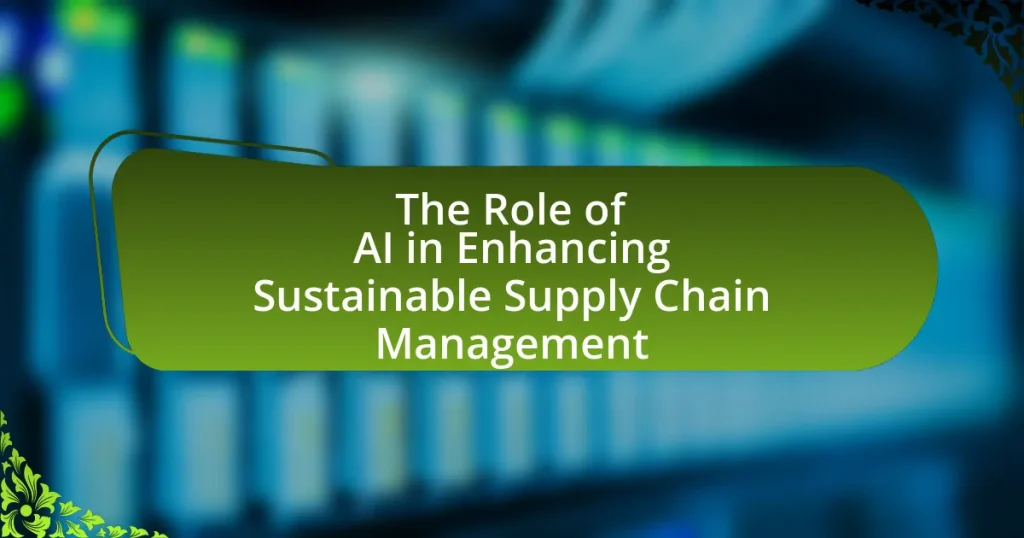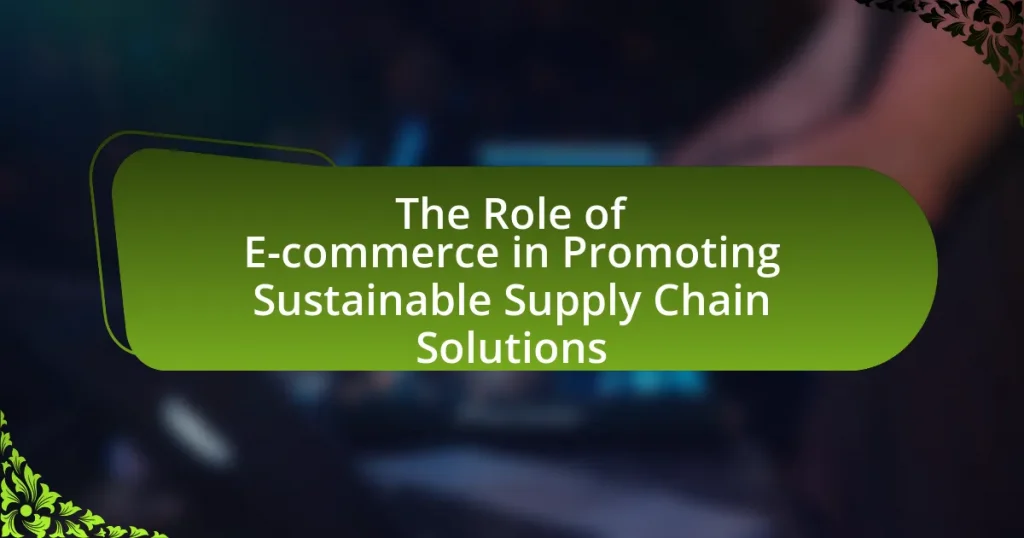Leading sustainability software platforms are specialized tools that assist organizations in managing their environmental, social, and governance (ESG) performance. This article provides a comprehensive comparison of various platforms, such as SAP Sustainability Management, Enablon, and Sphera, highlighting their key features, benefits, and contributions to sustainability efforts. It discusses essential functionalities like data management, real-time analytics, compliance tracking, and user-friendly interfaces, as well as the importance of integration with existing systems. Additionally, the article outlines best practices for selecting a platform, common pitfalls to avoid, and the impact of data analytics on sustainability initiatives.

What are Leading Sustainability Software Platforms?
Leading sustainability software platforms are specialized tools designed to help organizations manage and improve their environmental, social, and governance (ESG) performance. These platforms, such as SAP Sustainability Management, Enablon, and Sphera, provide functionalities for tracking carbon emissions, managing supply chain sustainability, and ensuring compliance with regulations. For instance, SAP Sustainability Management integrates with existing business processes to provide real-time insights into sustainability metrics, enabling companies to make data-driven decisions. The effectiveness of these platforms is supported by their ability to streamline reporting, enhance transparency, and facilitate stakeholder engagement, which are critical for achieving sustainability goals.
How do these platforms contribute to sustainability efforts?
These platforms contribute to sustainability efforts by providing tools that enable organizations to track, measure, and reduce their environmental impact. For instance, many sustainability software platforms offer features such as carbon footprint calculators, resource management systems, and compliance tracking, which help businesses identify areas for improvement. According to a report by the Global Reporting Initiative, companies using sustainability software can reduce their greenhouse gas emissions by up to 30% within a few years, demonstrating the effectiveness of these tools in promoting sustainable practices.
What key features define leading sustainability software platforms?
Leading sustainability software platforms are defined by features such as comprehensive data management, real-time analytics, user-friendly interfaces, and robust reporting capabilities. Comprehensive data management allows organizations to collect, store, and analyze sustainability-related data from various sources, ensuring accuracy and accessibility. Real-time analytics enable users to monitor performance metrics and make informed decisions quickly, enhancing responsiveness to sustainability challenges. User-friendly interfaces facilitate ease of use, allowing stakeholders at all levels to engage with the software effectively. Robust reporting capabilities provide detailed insights into sustainability performance, often aligning with regulatory requirements and industry standards, which is crucial for transparency and accountability.
How do these features enhance sustainability practices?
These features enhance sustainability practices by providing tools for data tracking, analysis, and reporting, which enable organizations to monitor their environmental impact effectively. For instance, real-time data analytics allows companies to identify inefficiencies in resource usage, leading to reduced waste and lower carbon footprints. Additionally, features like automated reporting streamline compliance with environmental regulations, ensuring that organizations meet sustainability standards. Research indicates that companies utilizing advanced sustainability software can achieve up to a 30% reduction in energy consumption, demonstrating the tangible benefits of these features in promoting sustainable practices.
What are the primary benefits of using sustainability software platforms?
The primary benefits of using sustainability software platforms include enhanced data management, improved compliance tracking, and increased operational efficiency. These platforms enable organizations to collect, analyze, and report sustainability data effectively, which supports informed decision-making. For instance, a study by the Global Reporting Initiative found that companies using sustainability software can reduce their reporting time by up to 50%, allowing for more accurate and timely disclosures. Additionally, these platforms often integrate with existing systems, streamlining processes and reducing manual errors, which further enhances productivity and compliance with environmental regulations.
How do these platforms improve operational efficiency?
These platforms improve operational efficiency by automating data collection and analysis, which reduces manual effort and errors. For instance, sustainability software can streamline reporting processes by integrating with existing systems, allowing organizations to gather real-time data on resource usage and emissions. This integration leads to faster decision-making and more accurate tracking of sustainability goals. According to a study by the International Institute for Sustainable Development, companies using such platforms reported a 30% reduction in time spent on compliance reporting, demonstrating significant efficiency gains.
What role do they play in regulatory compliance?
Sustainability software platforms play a crucial role in regulatory compliance by providing tools that help organizations track, manage, and report their environmental impact in accordance with legal requirements. These platforms facilitate data collection and analysis, ensuring that companies adhere to regulations such as the EU’s Green Deal or the U.S. Environmental Protection Agency standards. By automating compliance processes and generating reports, these software solutions reduce the risk of non-compliance penalties and enhance transparency, which is increasingly demanded by stakeholders.

How do Different Sustainability Software Platforms Compare?
Different sustainability software platforms vary significantly in features, usability, and integration capabilities. For instance, platforms like Enablon and Sphera offer comprehensive environmental, health, and safety management tools, while others like EcoStruxure focus on energy management and efficiency. Enablon is known for its robust reporting and compliance features, serving large enterprises, whereas smaller businesses may prefer simpler solutions like Sustainably, which emphasizes user-friendly interfaces and cost-effectiveness. Additionally, platforms such as Gensuite provide customizable modules that cater to specific industry needs, enhancing flexibility. The comparison of these platforms reveals that the choice largely depends on organizational size, specific sustainability goals, and budget constraints.
What criteria should be used for comparison?
The criteria for comparison of leading sustainability software platforms should include functionality, user experience, integration capabilities, scalability, and cost-effectiveness. Functionality assesses the range of features offered, such as carbon footprint tracking, reporting tools, and compliance management. User experience evaluates the interface design and ease of use, which can significantly impact user adoption. Integration capabilities determine how well the software connects with existing systems, such as ERP or CRM platforms, which is crucial for seamless data flow. Scalability examines whether the software can grow with the organization’s needs, accommodating increased data and users over time. Cost-effectiveness analyzes the pricing structure relative to the features provided, ensuring that organizations receive value for their investment. These criteria are essential for making informed decisions when selecting a sustainability software platform.
How do user interfaces differ among platforms?
User interfaces differ among platforms primarily in design, functionality, and user experience. For instance, web-based platforms often prioritize accessibility and responsiveness, adapting to various screen sizes, while mobile applications focus on touch interactions and simplified navigation to enhance usability on smaller devices. Additionally, desktop applications may offer more complex features and multitasking capabilities due to greater processing power and screen real estate. Research indicates that user satisfaction can vary significantly based on these interface differences, with studies showing that intuitive design leads to higher engagement and productivity across different platforms.
What are the pricing models of leading platforms?
Leading sustainability software platforms typically utilize three primary pricing models: subscription-based, pay-per-use, and tiered pricing. Subscription-based models charge users a recurring fee, often monthly or annually, providing access to the software and its features. Pay-per-use models charge users based on their actual usage of the platform, making it cost-effective for those with variable needs. Tiered pricing offers different levels of service at varying price points, allowing users to select a plan that best fits their requirements. These models are designed to accommodate diverse user needs and budgets, ensuring accessibility and flexibility in the adoption of sustainability solutions.
What are the strengths and weaknesses of popular platforms?
Popular sustainability software platforms exhibit strengths such as comprehensive data analytics capabilities, user-friendly interfaces, and robust reporting features, while weaknesses often include high costs, complexity in integration, and varying levels of customer support. For instance, platforms like Salesforce Sustainability Cloud provide extensive data visualization tools, enhancing decision-making, but may require significant investment and training for effective use. Similarly, SAP’s sustainability solutions offer strong integration with existing enterprise systems, yet users frequently report challenges in navigating the software’s complexity. These factors highlight the dual nature of popular platforms in the sustainability sector, where benefits must be weighed against potential drawbacks.
How does Platform A excel in feature offerings?
Platform A excels in feature offerings by providing a comprehensive suite of tools designed for sustainability management, including real-time data analytics, customizable reporting, and integration capabilities with existing enterprise systems. These features enable organizations to track their sustainability metrics effectively and make informed decisions based on accurate data. For instance, Platform A’s real-time analytics allow users to monitor energy consumption and carbon emissions instantly, facilitating timely interventions that can lead to significant reductions in environmental impact. Additionally, customizable reporting features empower users to generate tailored insights that align with specific organizational goals, enhancing strategic planning and accountability in sustainability initiatives.
What limitations does Platform B have in terms of user support?
Platform B has limitations in user support primarily due to its restricted availability of live assistance and limited response times for inquiries. Users often report that support is only accessible during specific hours, which can hinder timely resolution of issues. Additionally, the platform lacks comprehensive self-help resources, such as detailed FAQs or tutorial videos, which can leave users without adequate guidance. These factors contribute to a less responsive support experience compared to competitors that offer 24/7 assistance and extensive knowledge bases.

What Specific Features Should Users Look For?
Users should look for features such as data tracking, reporting capabilities, user-friendly interfaces, integration options, and compliance management in sustainability software platforms. Data tracking allows organizations to monitor their environmental impact effectively, while robust reporting capabilities enable users to generate insights and communicate sustainability efforts clearly. A user-friendly interface enhances accessibility for all team members, and integration options ensure compatibility with existing systems. Compliance management features help organizations adhere to regulations and standards, which is crucial for maintaining sustainability initiatives. These features collectively enhance the effectiveness and usability of sustainability software platforms.
How do data analytics capabilities impact sustainability efforts?
Data analytics capabilities significantly enhance sustainability efforts by enabling organizations to make data-driven decisions that optimize resource use and reduce environmental impact. For instance, companies can analyze energy consumption patterns to identify inefficiencies and implement targeted interventions, leading to a reduction in carbon emissions. A study by McKinsey & Company found that organizations leveraging advanced analytics can reduce their greenhouse gas emissions by up to 30% through improved operational efficiencies. This demonstrates that effective data analytics not only supports sustainability goals but also drives measurable environmental benefits.
What types of data can be analyzed for sustainability reporting?
Sustainability reporting can analyze various types of data, including environmental, social, and governance (ESG) metrics. Environmental data encompasses carbon emissions, energy consumption, water usage, and waste management. Social data includes labor practices, community engagement, and diversity metrics. Governance data focuses on corporate policies, compliance, and ethical practices. These data types are essential for assessing an organization’s sustainability performance and aligning with frameworks such as the Global Reporting Initiative (GRI) and the Sustainability Accounting Standards Board (SASB).
How do analytics features enhance decision-making?
Analytics features enhance decision-making by providing data-driven insights that inform strategic choices. These features enable organizations to analyze trends, identify patterns, and forecast outcomes based on historical data. For instance, a study by McKinsey & Company found that companies leveraging advanced analytics can improve their decision-making speed by 5 to 10 times compared to those relying on intuition alone. This capability allows businesses to make more informed, timely, and effective decisions, ultimately leading to better performance and competitive advantage.
What integrations are essential for effective sustainability software?
Essential integrations for effective sustainability software include data management systems, carbon accounting tools, supply chain management platforms, and regulatory compliance databases. These integrations enable seamless data flow, enhance reporting accuracy, and facilitate real-time monitoring of sustainability metrics. For instance, integrating with carbon accounting tools allows organizations to track emissions effectively, while supply chain management platforms help assess the sustainability of suppliers. Additionally, regulatory compliance databases ensure that organizations adhere to environmental regulations, thereby minimizing legal risks. Such integrations are critical for comprehensive sustainability management and informed decision-making.
How do integrations with existing systems improve functionality?
Integrations with existing systems enhance functionality by enabling seamless data exchange and process automation. This connectivity allows organizations to leverage their current technology investments, ensuring that information flows smoothly between different platforms, which reduces manual data entry and minimizes errors. For instance, a study by McKinsey & Company found that companies that effectively integrate their systems can improve operational efficiency by up to 30%. This efficiency gain translates into faster decision-making and improved responsiveness to market changes, ultimately leading to better overall performance.
What third-party tools are commonly integrated with these platforms?
Common third-party tools integrated with leading sustainability software platforms include Salesforce, Microsoft Power BI, and Tableau. These integrations enhance data analytics, reporting capabilities, and customer relationship management. For instance, Salesforce allows for streamlined communication and data sharing, while Microsoft Power BI and Tableau provide advanced visualization and analytical tools that help organizations track sustainability metrics effectively. Such integrations are crucial for organizations aiming to optimize their sustainability efforts through data-driven insights.
What are best practices for selecting a sustainability software platform?
Best practices for selecting a sustainability software platform include assessing the platform’s ability to meet specific sustainability goals, ensuring user-friendliness, and evaluating integration capabilities with existing systems. Organizations should prioritize platforms that offer customizable features tailored to their unique needs, as this enhances usability and effectiveness. Additionally, it is crucial to consider the platform’s data analytics capabilities, which can provide insights into sustainability performance and help track progress over time. Research indicates that 70% of organizations that utilize data-driven decision-making in sustainability initiatives report improved outcomes, highlighting the importance of robust analytics in software selection. Furthermore, reviewing customer support and training options can ensure that users maximize the platform’s potential, contributing to successful implementation and ongoing use.
How can organizations assess their specific needs before choosing a platform?
Organizations can assess their specific needs before choosing a platform by conducting a thorough analysis of their operational requirements, stakeholder expectations, and sustainability goals. This involves identifying key functionalities that align with their objectives, such as data tracking, reporting capabilities, and user accessibility. Additionally, organizations should engage with stakeholders to gather insights on their needs and preferences, ensuring that the selected platform supports collaboration and meets diverse user demands. A study by the International Institute for Sustainable Development highlights that organizations that align platform features with their strategic goals experience a 30% increase in operational efficiency, underscoring the importance of this assessment process.
What common pitfalls should be avoided during the selection process?
Common pitfalls to avoid during the selection process of sustainability software platforms include inadequate needs assessment, overlooking user experience, and neglecting integration capabilities. Inadequate needs assessment can lead to selecting a platform that does not align with organizational goals, resulting in wasted resources. Overlooking user experience may cause low adoption rates among staff, as a complex interface can hinder usability. Neglecting integration capabilities can create data silos, making it difficult to leverage existing systems effectively. These pitfalls can significantly impact the overall effectiveness and efficiency of the selected software platform.



